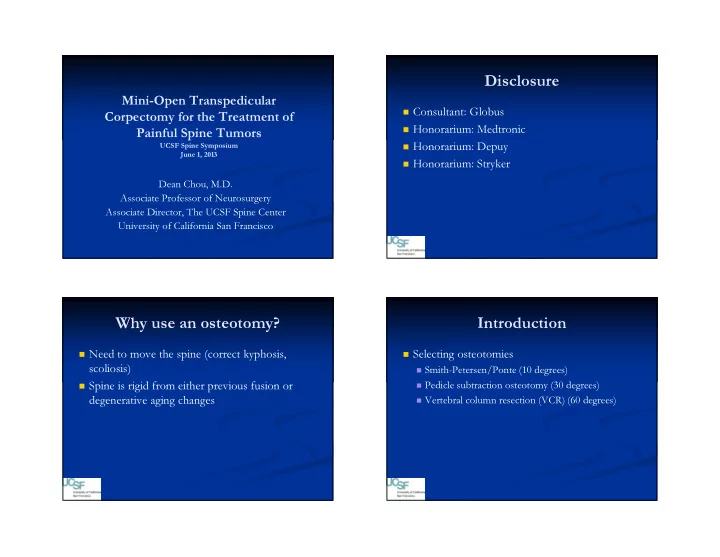

Disclosure Mini-Open Transpedicular � Consultant: Globus Corpectomy for the Treatment of � Honorarium: Medtronic Painful Spine Tumors UCSF Spine Symposium � Honorarium: Depuy June 1, 2013 � Honorarium: Stryker Dean Chou, M.D. Associate Professor of Neurosurgery Associate Director, The UCSF Spine Center University of California San Francisco Why use an osteotomy? Introduction � Need to move the spine (correct kyphosis, � Selecting osteotomies scoliosis) � Smith-Petersen/Ponte (10 degrees) � Pedicle subtraction osteotomy (30 degrees) � Spine is rigid from either previous fusion or degenerative aging changes � Vertebral column resection (VCR) (60 degrees)
F. SCHWAB – SPINE MOBILIZATION Why Ponte osteotomy? ANATOMICAL CONSIDERATIONS � Straightforward 6 Grades of Destabilization: � Effective 1. Partial facet joint � Fast 2. Complete facet joints � Can do a multiple levels 3. Partial body* 4. Partial body and disc* � Smooth, gradual 5. Complete body + discs* correction of kyphosis 6. >1 body, adjacent* *posterior vs . anteroposterior Reasons not to do a Ponte osteotomy Pedicle subtraction osteotomy � Sharp, angular kyphosis � Anterior column intact � Significant kyphosis � Hinge dorsally needing more than 10 � Cut wedge, not square degrees of � Consider removal of the correction/level disc also � Rigid, circumferential or � Average 30 degrees anterior solid fusion correction masses
Indications PSO � Sharp, angular kyphosis � Flatback syndrome after iatrogenic fusion � Needing approximately 30 degrees of correction � Average 11cm of sagittal correction per PSO VCR Mini-open vertebrectomy � Essentially a posterior based corpectomy � Technically challenging � Use the skills and techniques from posterior � Must be familiar with open VCR corpectomies � Must be comfortable with percutaneous pedicle � Extremely unstable, be careful of both screws translation and spinal cord lengthening during � Easiest to start with thoracic kyphosis. operation � Consider kyphotic tumor case to start
Skin incision—make single midline Evolution of mini-open incision or multiple stab incisions? vertebrectomy (Fessler) � T6 Metastatic hepatocelluar carcinoma � Cord compression � Gait disturbance � Neurologic deficit Single skin incision Place Jamshidi needles
Jamshidi’s in Place k-wires in Open fascia or skin Tap goes in
Tap under fluoro Place screw—control k-wire Place temporary rod to prevent Start laminectomy translation
Remove towers after rod in Place expandable cage Same skin incision—but is it the Skin closure same surgery? Open Mini open
F. SCHWAB – SPINE MOBILIZATION Evolution to mini-open VCR ANATOMICAL CONSIDERATIONS � Similar steps to corpectomy 6 Grades of Destabilization: � Similar principles 1. Partial facet joint 2. Complete facet joints � Consider not using the biggest possible cage. 3. Partial body* 4. Partial body and disc* 5. Complete body + discs* 6. >1 body, adjacent* *posterior vs . anteroposterior Open transpedicular corpectomy THE TRADITIONAL POSTERIOR APPROACH Kyphosis correction during posterior based vertebrectomy using cantilever technique
Contour rods into the shape you Implants placed. Laminectomy done want spine to look Cantilever to correct kyphosis Post correction
Can we do the same thing less Breast cancer—kyphosis correction via Mini-Open approach invasively? � Mini-open corpectomy with kyphosis correction Kyphosis intraop picture Cage insertion
Kyphosis correction Kyphosis correction VCR for severe thoracic kyphosis Preop � Severely limited in � 80 yo female with 90 degree thoracic kyphosis ambulation � Failed non-surgical care � Chronic narcotic use � Wished to proceed with surgery � Sits in chair all day � Understood significant risk of surgery � 90 degrees kyphosis � Planned mini-open VCR given age � 2 compression fractures above & below � Cement augmentation given osteoporosis
Standard skin incision Preserve fascia Jamshidi needles placed Place proximal screws
Place distal screws Multiple Jamshidis save on fluoro Open fascia over VCR site only Begin laminectomy
Complete VCR—temporary rod Place cage for pivot Thread rod through fascia—cut the Correct kyphosis—rod in shape of fascia distal end how you want spine to be
Fascial opening Drains placed, skin closed Conclusions � Use the same principles as in open surgery— � 500cc EBL correct kyphosis � No intraop � After a vertebrectomy, you’ve essentially done a transfusion VCR—take advantage of it � Back pain much � Be careful in osteoporotic patients— better instrumentation is very powerful and bone- � Caveat:s: cement screw interface may not be. PE, new adjacent fracture at L4
Thank you!
Recommend
More recommend